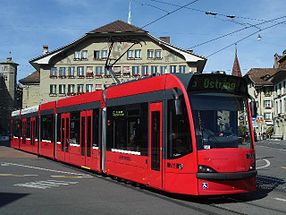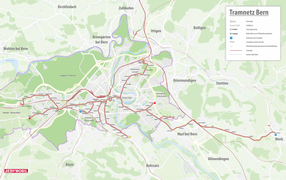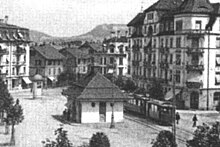Bern tram
| Bern tram | |
|---|---|
| Combino tram on the casino square | |
| Basic information | |
| Country | Switzerland |
| city | Bern |
| opening | October 1, 1890 |
| operator | Bernmobil |
| Transport network | Libero |
| Infrastructure | |
| Route length | 39.6 km |
| Gauge | 1000 mm ( meter gauge ) |
| Power system | 600 volts DC |
| Operating mode | Furnishing operation |
| Stops | 71 |
| business | |
| Lines | five |
| statistics | |
| Passengers | 45.9 million (as of 2011) |
| Mileage | 3.7 million km (as of 2011) |
| Line network | |
The Bern tram, known as the tram in German-speaking Switzerland, has been the tram operator of the Swiss federal city of Bern since 1890 . The tram is operated by the public transport company Städtische Verkehrsbetriebe Bern (SVB), which has been operating under the marketing name Bernmobil since 2000 and has been a legally independent company since 1999. This also operates a large part of the urban bus traffic that began in 1924, as well as the Bern trolleybus, which opened in 1940 . Initially, the tram was operated by the Berner Tramway-Gesellschaft (BTG), between 1900 and 1999 by the city itself. Until 1947 the responsible service department was called the Bern City Trams (SSB), then the Bern City Transport Company (SVB).
The meter-gauge tram network in Bern is served by five lines . One of them goes over to the Bern – Worb Dorf railway , the infrastructure of which belongs to the Bern – Solothurn regional traffic (RBS) and with which the urban tram is traditionally closely linked. The same used to apply to the Zollikofen – Bern line . Like the other means of transport in the region, the Bern tram is also integrated into the Bern-Solothurn fare network.
Lines
There are currently five tram lines in Bern with a total length of 39.584 kilometers:
| line | route | Stations | length | Travel time | Art |
|---|---|---|---|---|---|
| 3 | Bern train station - Weissenbühl | 7th | 2.067 km | 8-9 min | Radial line |
| 6th | Fischermätteli - Worb village | 24 | 13.067 km | 39 min | Diameter line |
| 7th | Bümpliz - Ostring | 23 | 8.109 km | 29-30 min | Diameter line |
| 8th | Brno Westside Railway Station - Saali | 27 | 10.383 km | 36 min | Diameter line |
| 9 | Wabern - Wankdorf train station | 21st | 5,958 km | 28 min | Diameter line |
Traffic performance
In 2011, the Bern tram provided the following transport services:
- Kilometers driven: 3,745,000, which corresponds to 32% of Bernmobil's total transport performance
- Passengers carried: 45,923,000, this corresponds to 48% of the total transport performance of Bernmobil
- Passenger- kilometers: 99,595,000, this corresponds to 49% of the total transport performance of Bernmobil
history
Air tram
On July 18, 1889, the Federal Office of Transport (EAV) granted the Berner Tramway Company an 80-year concession to operate the Bernese tramway. Construction work could begin immediately afterwards; the first line was opened as a compressed air tram on October 1, 1890 . The "air tram", based on the system of the Parisian engineer Louis Mékarski , drove from the bear pit , where the depot was located, via the train station to the Bremgarten cemetery . At both ends there was a turntable for turning the vehicles. In the winter months, however, the compressed air lines often froze, resulting in days of business interruption.
Steam tram

In view of these problems and the topography, the voters of the city of Bern gave preference to the operation of a second line of steam trams. From 1894 these operated as Line II from Länggasse via the train station, Mattenhofquartier (Eigerplatz) and Weissenbühl to Wabern , the existing route was henceforth designated as Line I. The depot for the steam trams was built in the Mattenhof district. The main tram depot is still located here today. With this new tram line, the horse-drawn bus was displaced from the city center, but from then on it served a new connection from Wabern to Belp- Steinbach. In the meantime there were plans to extend the steam tram to Kehrsatz and Belp.
An interest group from politics and business in various potential neighboring communities now vehemently advocated the construction of a steam-powered overland tram from Bern to Worb . In Gümligen, this should enable connections to the standard-gauge railway lines to Bern, Thun and the Emmental . BTG helped with the planning and calculation of the costs and applied for the required license on behalf of the interest group. The SAB issued this on December 23, 1896. The 9.7 km long connection was opened on October 21, 1898. The Bern – Worb Railway (BWB) ran until March 31, 1904 under the care of the BTG and the SSB.
electrification
At the turn of the century, developments in urban tram networks at home and abroad had not gone unnoticed. When a third line was planned at that time, the intention was to operate it electrically from the start. Thereafter, the two existing lines should be electrified. Above all, the residents of the Kirchenfeld area on the other side of the Aare opposed the overhead line . But at the ballot box, the electrification plans were given priority. In the same vote, a popular initiative to keep the air tram on Line I also had no chance.
On July 1, 1901, operations on line III began. This led from the Breitenrain over the Zytglogge to the Burgernziel. For four and a half months, Bern had three different types of tram traction at the same time. With the opening of the Gürbetalbahn , the horse-drawn bus could be replaced. The plans for an extension of Line II were abandoned. November 15th was the last day of operation of the air tram. The old depot and a bus shelter at Bärengraben still bear witness to the air tram era. None of the vehicles have survived. The Bärengraben depot was given up and sold three years later.
The Burgernziel depot, which still exists today, was ready to move into just in time for winter. Electrical operations on Line II began on January 29, 1902. 24 two-axle and seven maximum motor vehicles , as well as the twelve former steam tram trailers, were available for this purpose. Bern remained the only Swiss tram operator that procured Maximum railcars. In the course of 1902, the SSB also trained the horse-drawn tram drivers from the city of Biel to become wagon drivers for electric trams, so that the smooth transition to the new type of traction could take place there at New Year's 1903.
In the summer of 1904, eight short summer sidecars were added. These quickly enjoyed great popularity. Unexpectedly, damage to the chassis frame occurred in those two-axle motor vehicles that were mostly assigned to Line I. These were obviously caused by the Demer rails that were laid there. The SSB was forced to replace them much earlier than planned. The first six closed two-axle trailers arrived at the end of 1905. From 1906 (until 1914) a total of 29 two-axle motor vehicles were commissioned in several partial deliveries. These were stronger than their predecessors and no longer asymmetrical.
The fourth line, line IV, was the first radial line . It led from the train station to the Brückfeld. The regular service could be started on June 27, 1908. In view of the Federal Shooting Festival in 1910 , line III was extended to Papiermühlestrasse in the previous winter half-year. In addition, four more two-axle trailers were purchased. In 1909 over ten million passengers in Bern used the tram for the first time.
In 1911 the SSB changed the routing of lines II, III and IV. The station was now the central transfer point. The trains of line II now run from Weissenbühl to Papiermühlestrasse, those of line III from Länggasse to Burgernziel and those of line IV from Wabern to Brückfeld. With the opening of the section from Hirschengraben to Friedheim through the Monbijou -Quartier in October 1912, the trains on Line IV could now run directly to Wabern without the detour via the Mattenhofquartier and Weissenbühl. The Weissenbühl – Friedheim connection has served as an operating line since then . At the same time, a new line network came into force, the lines were henceforth designated with letters as follows:
- Line A: Bärengraben - Bahnhof - Friedhof (previously Line I)
- Line B: Weissenbühl - Bahnhof - Papiermühlestrasse (previously Line II)
- Line C: Länggasse - Bahnhof - Burgernziel (previously Line III)
- Line D: Wabern - Friedheim - Bahnhof - Brückfeld (previously Line IV)
However, the letter designations did not prove their worth, which is why in the same year the Arabic numerals, which are still used today, were changed, but as a special feature each terminal was assigned its own digit:
- Line 1: Bärengraben - Friedhof / Line 2: Friedhof - Bärengraben (previously Line A)
- Line 3: Weissenbühl - Papiermühlestrasse / Line 4: Papiermühlestrasse - Weissenbühl (previously Line B)
- Line 5: Länggasse - Burgernziel / Line 6: Burgernziel - Länggasse (previously Line C)
- Line 8: Wabern - Brückfeld / Line 9: Brückfeld - Wabern (previously Line D)
Trains that did not run to Wabern, but turned around at Friedheim, ran as line 7. The number of two-axle trailers was expanded by a further seven units.
With the double-track expansion of the lines in the Länggasse and Brückfeld in 1913, the state exhibition that took place a year later was announced. During the Landi, the SSB was responsible for running the circular route through the exhibition. In order to be able to cope with the passenger feeder traffic, the SSB procured another 20 two-axle trailers. These were the last two-axle vehicles to be purchased and the last trailers to be bought for almost two decades. A total of 60 motor vehicles and 54 trailers were now available.
In the first World War
In the summer of 1914, world politics also affected the tram operation in Bern. The Federal Council ordered the general mobilization of the army on August 2nd. As a result, the SSB lacked 125 employees from all areas. With a workforce of 319 bc, this corresponds to around 40 percent. In order to be able to alleviate the shortage of personnel, the company needed 144 "auxiliary conductors". Women were not allowed to be employed at the time.
So that the line of the Worblentalbahn (WT) could be extended from the Papiermühlestrasse to the Kornhausplatz from July 19, 1915, the track spacing had to be increased in the curves first - due to the wider wagons of the railway - in order to avoid crossing bans. In the further years of the First World War, the SSB saw itself forced by inflation- related rise in prices (coal imports) to limit its activities to the bare minimum. The six round track motor vehicles, which were only used as summer trailers due to their weak engines, were converted into closed year-round vehicles. Three wagons became trailers. The summer superstructures were sold to the Zurich city tram .
In the summer of 1918, the SSB helped the Bern-Worb-Bahn several times on Sundays with tram compositions in order to transport the many day trippers despite the lack of wagons.
Interwar period
In 1919 the Bern municipal council debated two projects to expand the tram network. While he refused the extension of line 1/2 from Bärengraben to Ostermundigen for reasons of cost (slopes Aargauerstalden, Laubeggstrasse and Ostermundigenstrasse), he agreed to a tram line to Bümpliz . This tram connection was a compensation business for the incorporation to Bern, but it was only realized 91 years later.
After the war, the economic situation did not improve significantly at first. The SSB still only had to limit itself to the most essential maintenance work. The year 1920 closed with a deficit for the first time in the company's history. In 1920 and 1921 a total of 65 people had to be released. The sale of surplus spare parts to the Lucerne tram brought about 700 Swiss francs.
Between 1921 and 1932, the summer cars were converted into closed year-round trailers in our own workshop. Some vehicles were used as test vehicles for various bodies until, with one exception, they all received the large round platforms typical of Bern.
After 15 years, the route network was expanded again in 1923. When the branch line from Effingerstrasse to Fischermätteli went into operation on November 18, the Bern tram network was 18.2 kilometers long. This was the last new line to be built for almost a quarter of a century. With the new branch line, the line network experienced a slight change: the trains now ran from Brückfeld to Fischermätteli (line 11, opposite direction line 12). The line to Wabern became a radial line.
The Bern-Worb-Bahn's application to move the terminus from Helvetiaplatz over Kirchenfeldbrücke to Casinoplatz (Hotelgasse) was negatively affected by the city of Bern's authorities: They feared a significant deterioration in the traffic situation on the outskirts of the city center. This extension caused political discussions for the next eight decades, and this route was only realized at the end of the 1990s.
Since 1924, three-car trains have been running in rush hour for cost reasons. In the years that followed, the SSB was still unable to make any major expenses. Apart from the two extensions in the Brückfeld and the Wankdorf Stadium , which were only used on special occasions , maintenance work was mainly carried out on the tracks. Since the search for cheap used vehicles in Germany, where the hyperinflation of 1923 had driven tram operations into bankruptcy , did not produce the desired result, the rotten car bodies of the two-axle motor vehicles from 1901/1902 still had to be replaced. The maximum railcars received more powerful engines. The SSB hoped to extend their service life by 15 to 20 years. However, it was not possible to install rail brakes on these cars, which is why the majority of them continued to run on line 3/4. From 1928 pantographs replaced the previous lyra bar .
The major renovation work of 1930 in the Bahnhofplatz / Bubenbergplatz area not only changed the image of the city in this area, but also the lines of the SSB. A large parking facility for trams ("Blasermätteli") was built on Bubenbergplatz. The station was stripped of its large entrance hall and the front was moved to the rear. The SSB took the opportunity to reorganize the network and introduced the colored route boards, some of which are still used today:
- Line 1/2 (blue): Friedhof - Bahnhof - Brückfeld
- Line 3/4 (white): Weissenbühl - Bahnhof - Papiermühlestrasse
- Line 5/6 (red): Länggasse - Bahnhof - Burgernziel
- Line 8/9 (yellow): Bärengraben - Bahnhof - Schönegg - Wabern (trains that only ran to Schönegg ran as line 7)
- Line 11/12 (green): train station - Fischermätteli
In August of the same year, the SSB received its first new build vehicles after 16 years. There were two four-axle Be 4/4 motor vehicles.
In 1931 the SSB applied for a license to extend line 5/6 by 800 meters through Muristrasse to Egghölzli. The cantonal authorities rejected the request on the grounds that the heavy motor vehicle traffic meant that a double-lane route in Muristrasse could not be justified. In 1932/1933 the "Landibahnzüge" were put together to form double wagons with bellows and a fixed connection. From now on they operated almost without exception on the 11/12 line. In 1933, three new trailers were put into operation: two four-axle vehicles and one three-axle vehicle with SLM steering frame.
The first signs of the global economic crisis were felt in Switzerland as early as 1932. The yields decreased more and more. Unemployment finally peaked in 1936 . Nevertheless, the SSB continued to carry out major work on the track system. At the same time, the SSB began to demolish the two-axle trailers from 1905 and 1910 and to build new vehicles in their own workshop, using parts of the chassis. The former steam tram trailers gradually received new car bodies and boarded platforms. In December 1935, delivery of seven four-axle motor vehicles began. This meant the end for the old maximum railcars. One survived until 1975 as a welding car.
September 19, 1936 is the blackest day in the history of the tram. At the Henkerbrünnli stop on line 1, fallen leaves were lying on the wet rails. On the way back from a football match under braking as a use rate traffic forming Dreiwagenzug and also drove therefore with great force to the standing facing head on. 28 passengers were injured, some seriously.
In World War II
At the beginning of 1939 a flu epidemic caused a fifth of the workforce to be absent at times. When the Federal Council finally proclaimed general war mobilization in late summer of the same year , a large proportion of the SSB employees had to join the army, which caused numerous restrictions. Nevertheless, this year, for the first time, more than 20 million passengers used the tram.
As a result of the war, there was no celebration of the 50th anniversary of the tram in Bern in 1940. The tram network has been completely double-tracked since 1941. In the following years, restrictions of all kinds shaped public transport in the federal city. As the war went on, the shortage of materials became increasingly noticeable. The transport numbers rose sharply.
The last vehicles with longitudinal benches arrived in 1944. These five four-axle motor vehicles and six four-axle sidecars were the last vehicles that the SSB procured. The special feature of the motor vehicles was that there were already compressed air-operated folding doors on one side, but only simple sliding doors on the other.
post war period
The blackout was lifted on October 1st after three years. Shortly after the end of the war in 1945, the SSB returned to five-minute intervals. The electorate approved the extension of line 5/6 from Burgernziel to Freudenbergerplatz (Ostring). This could be put into operation on December 1, 1946.
As a result of the merger of the SSB with the bus company Stadt-Omnibus Bern (SOB) on September 1, 1947 - from now on there was also a uniform tariff for all urban means of transport - the routes of the tram changed. At the same time, the separate numbering according to the direction of travel was abolished by eliminating the even line numbers:
- Line 1: Güterbahnhof (formerly cemetery) - train station - Brückfeld
- Line 3: Weissenbühl - Bahnhof
- Line 5: Länggasse - Bahnhof - Ostring
- Line 9: Wabern - Bahnhof - Militärplatz (formerly Papiermühlestrasse)
- Line 11: Fischermätteli - train station
The first ten standard motor vehicles arrived in the fall, and five more followed the following spring. These were the first Bernese tram cars with a passenger flow . The conductor was given a permanent seat by the third door. The renewal program for older rolling stock was continued. A planned takeover of trailers 41 to 46, which were identical to the Bernese wagons, from the Biel tram operation, which was discontinued in 1948, did not materialize, however, because the price could not be agreed. The numbers 215 to 220 provided for this purpose were never assigned.
The beginning boom brought an increase in motorized private transport at the end of the 1940s . At the same time, the number of transports steadily decreased. In 1951/1952 the SVB received ten four-axle trailers. These were based on the Swiss standard car proposed by the Association of Swiss Transport Organizations (VST) in 1945 . Together with the motor vehicles delivered four years earlier, large-capacity trains could now be formed. This made a large number of older rolling stock redundant. A storage hall for 20 to 24 two-axle vehicles was built at the Weissenbühl terminus. These represented the reserve for major events.
In the early summer of 1954, a traffic report from a Zurich consultancy suggested converting all of Bern's tram operations to buses. The model for this was the then modern concept of the car-friendly city . This met with resistance from the Bernese population, and there were demonstrations in favor of keeping the tram. In 1955, the renovation of the track system in front of the Eigerplatz depot began. During the renewal of the rails on the Kirchenfeld Bridge, buses in the replacement rail service provided the connection to the Ostring several times .
In 1958 all motor vehicles had to be equipped with indicators . In November of the same year, the SVB introduced express courses on the main train station - military place and central station - Ostring routes . In the same year, the renovation of the station began. As a direct result of the new construction of the Schanzenbrücke, the line Länggasse - Hauptbahnhof was switched to a bus. Line 5 ran from now on as the Fischermätteli diameter line (formerly line 11) - Hauptbahnhof - Ostring. Thus the «Landibahn» trains from 1914 lost their area of operation and could be scrapped together with the last steam tram trailers. The commissioning of the second series of standard trains (ten motor vehicles and ten trailers) led to the retirement of a large part of the remaining two-axle vehicles. The number of passengers rose by up to six percent annually.
In 1964, the citizens of Bern voted for a general ban on smoking in buses and trams. Thus, regulations such as the one that said that smoking was only allowed in the standing room could be overridden. With the conversion of line 1 to bus on October 11, 1965, the length of the tram network was reduced to 13.55 kilometers. Shortly afterwards, on November 21, 1965, the Zollikofen – Bern line of the Solothurn-Zollikofen-Bern Railway (SZB) received its underground entry into the Bern railway station, which also benefited the Solothurn – Worblaufen line . As a result, the connection between trams and railways in the animal hospital area ceased to exist .
Also in 1965, with the conversion of a standard train to conductorless operation, self-control was announced, which was introduced in stages two years later by 1973. With a view to replacing the old four-axle vehicles with longitudinal benches, the SVB took over a double-articulated trolley with four single-axle chassis from SWS Schlieren on a trial basis in August 1966. However, there was no serial order. The SVB opted for conventional eight-axle double articulated wagons with Jakobs bogies .
From the winter of 1972/1973 onwards, the majority of the new double-articulated cars were used on Line 9. In addition to the old four-axle vehicles with longitudinal benches, this also enabled the last two-axle vehicles to be scrapped. The Maximum railcar from 1902, which was converted into a work car, was replaced by a 30-year-old car and scrapped. With this the last representative of this type disappeared. On October 28, 1973, the 1.67-kilometer extension of line 3 from Burgernziel to the new Wittigkofen (Saali) district went into operation.
From May 26, 1974, the trains on the Worb Dorf – Worblaufen railway , which at that time was still operated by the United Bern-Worb-Bahnen (VBW), came from the direction of Worb directly to the underground station in Bern. This means that after 1965 the second link between trams and railways ceased to exist, which meant that an important source of income for the city of Bern dried up because the route usage fees charged at the forester's house from the city limits were no longer applicable. The redesigned Bubenbergplatz was inaugurated on September 4, 1976 as part of the big Bern Festival at the end of the 17-year renovation of the station. At the same time, the SVB presented the first dining car tram in Switzerland, created from a longitudinal bench motor car and an accompanying trailer. Also in 1976, line 9 on Seftigenstrasse was relocated to a separate route at around 800 meters. This enabled faster progress , particularly during rush hour .
Due to the unexpectedly high number of passengers caused by the "Bäreabi" introduced in 1984, there was an acute shortage of vehicles in the mid-1980s. The SVB therefore looked for well-preserved used vehicles. The takeover of five standard trains from Zurich or just as many DUEWAG trains from the Bielefeld Stadtbahn were considered . In 1986, five 40-year-old trailers were taken over by the Zurich Transport Authority, replacing the last six longitudinal bench trailers. In 1987 a Geneva low-floor articulated car and a Zurich high-floor vehicle of the Tram 2000 type made a guest appearance in Bern with a view to purchasing a new one . The Geneva low-floor vehicle was very popular with the population, which in 1990 ultimately led to the procurement of twelve eight-axle vehicles.
Also from 1987 onwards, the RBS trains coming from Worb Dorf ran via Helvetiaplatz to the Zytglogge. At the same time, they were given the line designation G, with the courses only running between Bern and Gümligen carrying a line signal painted in red .
In the summer of 1988 the Kirchenfeldbrücke was closed to traffic as a result of renovations, which led to the tram network being split in two. In order to enable operation on the eastern part, a provisional turning loop was created at Helvetiaplatz and from there it was driven to Ostring and Saali. The two specially set up bus routes 31 and 32 were used to connect the two sub-networks. In 1990, twelve low-floor articulated trolleys were put into operation, allowing the old Zurich wagons to be scrapped. Nevertheless, three years later the SVB again bought used trailers in Basel , which were later sold to Baselland Transport AG . Because of the rail replacement traffic in the course of the renovation of the Kornhausbrücke , additional buses from Baden-Wettingen and Lucerne also helped out.
At the end of the 1990s, a network optimization study suggested converting the previous car and trolleybus routes to Bümpliz, Bethlehem, Ostermundigen and Wyler to tram operation by 2020.
Tram Bern West 2010
On June 17, 2007, the voters of the canton of Bern approved the corresponding investment loan . On April 1, 2008, construction work began on the 6.8 kilometer long new line. It begins after the junction with line 6 and is used with the junction at the Bümpliz underpass from line 7 to Bümpliz and line 8 to Brünnen. The work was completed at the end of September 2010. Commissioning took place at the timetable change on December 12, 2010, and the current line concept has been in effect since then. At the same time, line G was renamed to line 6 after Worb Dorf and extended to Fischermätteli. With that, the last line of letters in Bernese local transport disappeared. In addition, RBS transferred the concession for this line to Bernmobil on November 30, 2010.
Development from 2011
As a result of complaints from residents about the noisy trams ("squeaky tram") of the RBS, line 6 was split into line 6 Zytglogge – Worb Dorf and bus line 6B Bern Bahnhof – Fischermätteli in spring 2011. With the timetable change on December 11, 2011, this situation, which was unattractive for passengers coming from outside the city, was ended again after the RBS Be 4/10 had been equipped with new wheels and the bends in Fischermätteli had been equipped with lubrication systems.
At the 2012 timetable change, line 9 from Guisanplatz was extended by three stations to Wankdorf station. The turning loop at the previous final stop at Guisanplatz remained.
A further network expansion was planned for the years 2014 to 2018. On the one hand by extending line 9, on the other hand by converting line 10 from bus to tram operation, which would have extended the tram network to Köniz and Ostermundigen .
The extension of line 9 by a short distance to a new Kleinwabern station on the Bern – Belp railway line (served by lines S3 and S31) was approved in the referendum on September 28, 2014 in Köniz.
Two long new lines would have been required for the new line 10. They would have branched off from today's line 3 in the west and would have led to Köniz / Schliern. A short end piece of line 3 would have been converted to bus and the previous line 3 would have been eliminated. In the east, line 10 would have branched off from line 9 and would have run to Ostermundigen / Rüti. In the referendum on September 28, both the voters from Köniz (61.4% no) and those from Ostermundigen (53.4% no) spoke out against the project, which means that it failed. The yes (61.3%) of those eligible to vote in Bern does not change this. On April 3, 2016, the residents of Ostermundigen voted again in favor of building a tram, after which the branch from Bern to Ostermundigen should still be realized.
vehicles
Current articulated motor vehicles
| Type | number | Numbers | Years of construction | Manufacturer | comment | |
|---|---|---|---|---|---|---|
 |
Be 4/10 “Tram 2000” owned by RBS |
9 | RBS 81-89 | 1987/1988 as Be 4/8, expanded by Stadler in 2010 |
SWP / SIG / FIG | Bidirectional car , overland train protection |
 |
Be 4/8 | 12 | 731-742 | 1989/1990 | Vevey / ABB / DUEWAG | Furniture trolley |
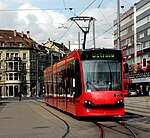 |
Be 4/6 Combino Advanced |
7th | 753-759 | 2002-2004 | Siemens | Furniture trolley |
 |
Be 6/8 Combino Advanced |
8th | 751, 752, 760-765 |
2002–2004 as Be 4/6, expanded in 2009 |
Siemens | One-way car, overland train protection |
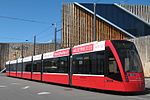 |
Be 6/8 Combino Classic |
21st | 651-671 | 2009/2010 | Siemens | Furniture trolley |
Former motor vehicles
| Type | number | Numbers | Years of construction | in use until | Manufacturer | Remarks | |
|---|---|---|---|---|---|---|---|
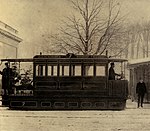 |
Cm 2/2 | 10 | 1-10 | 1890 | 1901 | Machine factory Bern | Air tram |
 |
G 3/3 | 8th | 11-18 | 1894 | 1901 | SLM | Steam tram locomotives |
| Ce 2/2 | 24 | 1-24 | 1901/1902 | 1961 | SWS / MFO | ||
| Ce 2/4 | 7th | 51-57 | 1901/1902 | 1936 | SIG / MFO | Maximum railcar, numbers 151–157 from 1913 | |
 |
Ce 2/2 | 29 | 25-53 | 1906-1914 | 1973 | SIG / MFO | |
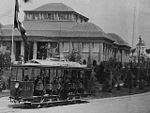 |
Ce 2/2 | 6th | 209-214 | 1914 | 1932 | SWS / MFO | Summer railcar of the circular railway of the 1914 state exhibition |
| Ce 4/4 | 2 | 158 + 159 | 1930 | 1973 | SIG / MFO | ||
| Ce 2/4 | 3 | 160-162 | 1932/1933 | 1959 | SWS / MFO | Permanently coupled two-car train with bellows for passenger circulation, developed from a motor car from the 209–211 series and a two-axle trailer from the 212–214 series | |
 |
Ce 4/4 | 7th | 144-150 | 1935/1936 | 1976 | SIG / MFO | 148 converted into welding car 503 in 1975 |
 |
Be 4/4 | 5 | 171-175 | 1944 | 1973 | SIG / MFO | "Fan" |
 |
Be 4/4 | 15th | 101-115 | 1947/1948 | 1997 | SWS / BBC / MFO | Standard car , numbers 601–615 from 1986 |
 |
Be 4/4 | 10 | 121-130 | 1960/1961 | 2003 | SWS / BBC / MFO | Standard car, from 1986 numbers 621–630 |
| Be 4/4 | 1 | 401 | 1966 | 1990 | SWS / MFO | Nickname "Muni", articulated vehicle prototype, from 1986 number 701 | |
 |
Be 8/8 | 16 | 711-726 | 1973 | until 2009 | SWS / BBC | "SAC-Tram", until 1986 numbers 1–16 |
Former trailer wagons
| Type | number | Numbers | Years of construction | In use until | Manufacturer | Remarks | |
|---|---|---|---|---|---|---|---|
| C4 | 12 | 19-30 | 1894 | 1959 | SIG | from 1901/04 numbers 71–79, from 1913 numbers 301–309 | |
| C2 | 8th | 101'-108 ' | 1904 | 1935 | SWS | Summer cars, from 1913 numbers 201' – 208 ', from the 1920s closed cars | |
| C2 | 6th | 121'-126 ' | 1905 | 1935 | SWS | from 1913 numbers 221'-226 ' | |
| C2 | 4th | 127-130 | 1910 | 1973 | SWS | from 1913 numbers 227–230, joint order with the Biel carriages 41–44 | |
| C2 | 7th | 131-137 | 1912 | 1973 | SWS | from 1913 numbers 231-237 | |
| C2 | 20th | 238-257 | 1914 | 1973 | SIG | ||
| C2 | 8th | 201 "-208" | 1929-1934 | 1973 | SWS / SSB | created using various parts from the 201' – 208 'series | |
| C3 | 1 | 310 | 1933 | 1973 | SWS / SLM | ||
| C4 | 2 | 311 + 312 | 1933 | 1973 | SIG | ||
| C2 | 6th | 221 "-226" | 1935 | 1973 | SWS / SSB | created using various parts from series 221'-226 ' | |
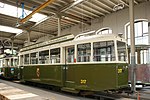 |
C4 | 6th | 313-318 | 1944/1945 | 1988 | SIG | "Babeli" |
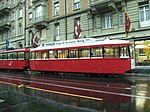 |
B4 | 10 | 321-330 | 1951/1952 | 2009 | FFA | By standard cars, 325, 326 and 330 Iasi issued |
 |
B4 | 10 | 331-340 | 1960/1961 | 2005 | SIG / SWS | By standard cars, 332, 334, 335 and 338-340 Iasi issued |
| B4 | 5 | 341'-345 | 1945/1946 | 1992 | SIG | formerly VBZ 711–713 and 718 + 719 | |
| B4 | 3 | 341 "-343" | 1947/1948 | 1998 | FFA | formerly BVB 1402, 1403 and 1406 |
Historic vehicles
| number | owner | Location | Remarks |
|---|---|---|---|
| 12 | Technorama | Bern, Eigerplatz | "Glettise" |
| 18th | Verkehrshaus | Lucerne, Museum of Transport | "Glettise" |
| 26th | Verkehrshaus | Lucerne, Museum of Transport | |
| 31 | BTG | Bern, Eigerplatz | Replica from 2002 |
| 37 | SVB | Bern, Weissenbühl | |
| 52 | Blonay – Chamby museum railway | Chaulin, museum | |
| 107 | SVB | Bern, Weissenbühl | from 1986 to 1999 listed as number 607 |
| 145 | SVB | Bern, Weissenbühl | Used as Märlitram for the LOEB department store until December 2004 , "Fondue Tram" in the winter quarter |
| 171 | SVB | Bern, Weissenbühl | formerly a wheelchair tram, only equipped with a longitudinal bench on one side, "Lufter" |
| 175 | Amitram | Lille, museum | in original condition, "air fan" |
| 204 | SVB | Bern, Weissenbühl | |
| 239 | SVB | Bern, Weissenbühl | |
| 311 | SVB | Bern, Weissenbühl | in the winter quarter "Fondue Tram" |
| 302 | Private | Goumoens-le-Jux (VD) | current number, car body only, without bogies |
| 312 | SVB | Bern, Eigerplatz | |
| 316 | Amitram | Lille, museum | "Babeli" |
| 317 | SVB | Bern, Weissenbühl | "Babeli" |
| 327 | SVB | Bern, Weissenbühl | |
| 337 | SVB | Bern, Weissenbühl | |
| 501 | SVB | Bern, Weissenbühl | Snow plow Xe 2/2, originally owned by the city of Bern, not operational |
| 502 | Kerzers / Kallnach Railway Museum | Bern, Weissenbühl | Snow plow Xe 2/2, inoperative |
| 503 | SVB | Bern, Weissenbühl | Welding trolley Xe 4/4 |
| 621 | SVB | Bern, Weissenbühl | formerly car 121 |
| 647 | SVB | Bern, Eigerplatz | formerly "Wagon-Restaurant" number 147 |
| 719 | SVB | Bern, Weissenbühl | formerly car 9 |
Trammuseum Bern and historical steam tram
The former Weissenbühl depot houses the Trammuseum Bern, it is the second Swiss tram museum after the Trammuseum Zurich , is looked after by the Tramverein Bern (TVB) and represents the history of the tram in Bern.
In addition, the Berner Tramway Company, founded in 2001, runs regular special tours on the Bern tram network during the summer season. An original steam tramway locomotive from 1894 and a trailer recreated in 2002 are used here.
Web links
Individual evidence
- ↑ a b Annual Report 2010 ( Memento of the original dated June 3, 2015 in the Internet Archive ) Info: The archive link was inserted automatically and has not yet been checked. Please check the original and archive link according to the instructions and then remove this notice. (PDF; 2.0 MB) on the Bernmobil website , accessed on December 2, 2012.
- ↑ Timetable according to lines. Bernmobil, accessed December 1, 2017 .
- ↑ a b c d e f g The Bern tram history began in 1890 with nine compressed air trams. Online edition of the Berner Zeitung on December 9, 2010, accessed on December 2, 2012.
- ↑ a b A century of “Nüünitram” online edition of Der Bund on October 3, 2012, accessed on December 2, 2012.
- ↑ Bern's tram history began in 1890 with nine compressed air trams , Berner Zeitung of December 9, 2010
- ↑ Description of Tramzug 145 + 311 ( Memento of the original from September 23, 2013 in the Internet Archive ) Info: The archive link was inserted automatically and has not yet been checked. Please check the original and archive link according to the instructions and then remove this notice. on the website of the Tramverein Bern , accessed on December 2, 2012.
- ↑ Tram Bern West clears the second hurdle in the SF Tagesschau's online archive , accessed on December 2, 2012.
- ↑ TramBernWest dossier ( memento of the original dated September 23, 2015 in the Internet Archive ) Info: The archive link was inserted automatically and has not yet been checked. Please check the original and archive link according to the instructions and then remove this notice. (PDF; 2.5 MB) on the Bernmobil website , accessed on December 2, 2012.
- ↑ Page no longer available , search in web archives: Transfer of concession line G, new line 6 of the SVB on the website of the Federal Office of Transport , accessed on December 2, 2012.
- ↑ As of December, the blue train will return to the Fischermätteli online edition of Der Bund on November 18, 2011, accessed on December 2, 2012.
- ↑ a b Köniz says no to tram line 10 and yes to tram extension 9. (No longer available online.) Municipality of Köniz, September 28, 2014, formerly in the original ; accessed on September 28, 2014 . ( Page no longer available , search in web archives ) Info: The link was automatically marked as defective. Please check the link according to the instructions and then remove this notice.
- ↑ Tram Region Bern; Voting result of September 28, 2014. (PDF) (No longer available online.) Ostermundigen municipality, September 28, 2014, archived from the original on September 24, 2015 ; accessed on September 28, 2014 . Info: The archive link was inserted automatically and has not yet been checked. Please check the original and archive link according to the instructions and then remove this notice.
- ↑ Minutes of the municipal vote of September 28, 2014. (PDF) City of Bern, September 28, 2014, accessed on September 28, 2014 .
- ^ [1] , report of the Berner Zeitung from April 3, 2016
